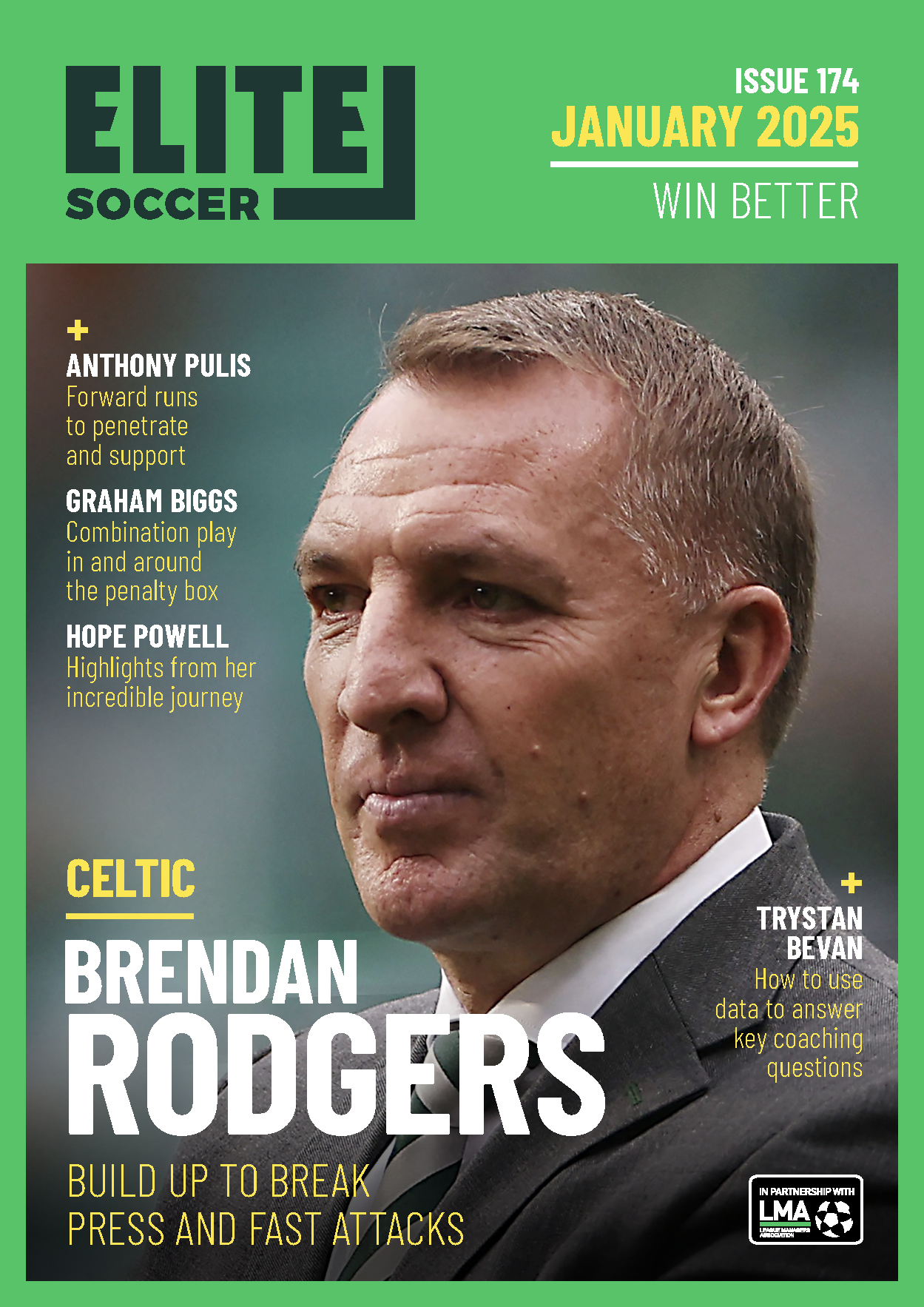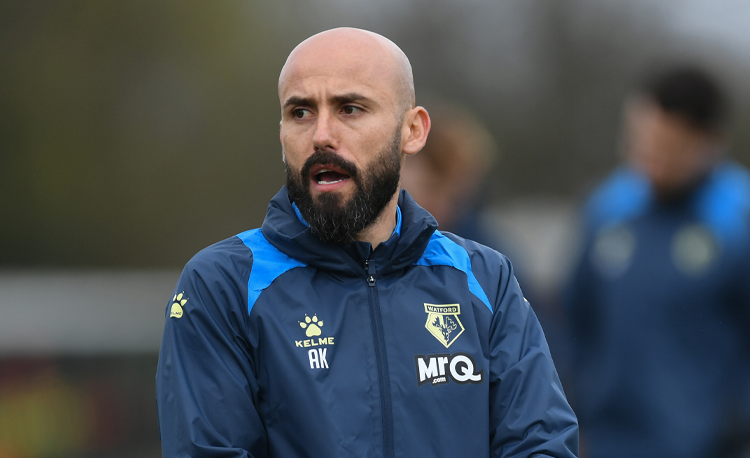You are viewing 1 of your 1 free articles
Defending principles
This session is all about building the defensive role of every position when out of possession. It starts with individuals defending in 1v1 and 3v2 situations and builds all the way through the units to whole team defending when out of possession. I like this session because all the problems posed to players are realistic to game situations.
| Area | Up to full pitch |
| Equipment | Balls, bibs, cones, 2 full size goals |
| No. of Players | Up to 19 players + 2 goalkeepers |
| Session Time |
Individual defending: 20mins, Team defending: 20mins, 11v10 game: 20mins |
This session is all about building the defensive role of every position when out of possession. It starts with individuals defending in 1v1 and 3v2 situations and builds all the way through the units to whole team defending when out of possession. I like this session because all the problems posed to players are realistic to game situations.
It allows me to coach good technique when defending in 1v1 situations in all relevant areas of the pitch. Despite not having the ball, I will try to encourage the defending player to take control of the 1v1 by focusing on his approach and distance from the attacker, by encouraging use of the body, by forcing the attacker away from our goal, and by using feints to tackle.
There is a huge focus on mindset in this session. I want to see a real desire from players to stop efforts on goal and I also want players to encourage each other and make demands of one another.
As these activities are used as a vehicle to reinforce the fundamentals of how we want to defend as a team, it is good to revisit this session, or parts of it, regularly and not just after a poor performance. It is also valuable when trying to integrate new players into the team, as it highlights clearly what is expected from them when the opposition have possession of the ball.
To make the session a success, the coach must be very clear about how he wants the team to defend in all areas of the pitch and also in which formation he wants the team to play, as this provides the detail for the session.
What do I get the players to do?
Individual defending
We set up in the final third with a goal and a goalkeeper at one end. We cone off an area in the centre of the pitch, with a wide zone on either side. We’re using nine outfield players split into a blue attacking team of five and a red defending team of four – the attackers are made up of two strikers and an attacking midfielder in the central zone and a wide midfielder in each of the wide zones, while the defending team have two centre backs in the central zone and a full back in each wide zone. It’s important from the outset to be clear to the players about how you want them to defend.
The first two attacks are in the central zone. The coach serves the ball to the attacking midfielder, who plays a one-two with one of the strikers and the attackers then combine to attack the goal in a 3v2, as shown [1a]. The centre backs should try to stop the attack or force the attackers wide.
1a

2. The centre midfielder plays a one-two with one of the two strikers and then the attackers combine to attack the goal in a 3v2
3. The two red centre backs should try to stop the blues from scoring
On completion of the first attack, the players reset and a second ball is played into the strikers for another 3v2. Again, the defenders should get to the ball and force the attack wide if possible, or clear the ball out of play, as shown [1b].
1b
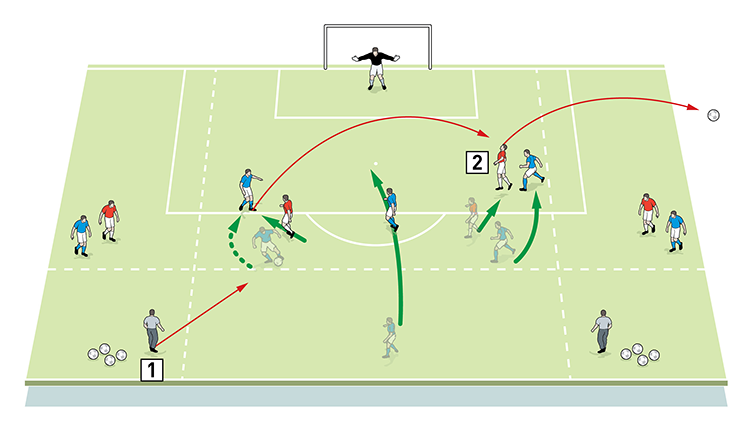
2. The centre backs should try to force the attackers out wide. Here one gains possession and clears the ball
After the second attack, the players reset for two attacks in the wide zones. First the coach plays a ball to the wide right attacker, who goes 1v1 against the full back and tries to create a goal scoring chance. For the final attack, the coach serves a ball to wide left attacker who goes 1v1 against the full back in the other wide zone, as shown [1c]. We then repeat all four attacks, rotating players as necessary.
1c

2. The attacker tries to create a goal scoring chance but is stopped from reaching the goal as the defender clears the ball
3. When the third attack is dead, the coach plays the ball to the wide left attacker, who goes 1v1 with the full back
To progress this session, the strikers in the central zone can join in with the third and fourth attacks, making runs to meet crosses delivered from wide.
What do I get the players to do next?
Team defending
Once the detail has been given to individual players within the back four and we’ve run them through their paces with the first drills, it is time to stretch them as a defensive unit. We would add two defensive midfielders to the defending team to help protect the centre of the pitch whilst still having attacking overloads for their opponents in the wide areas. This allows the coach to work on defending crosses, particularly the key positions of the defenders and centre midfielders in the box, and the screening and pressing duties of the midfielders.
We set up on half a pitch with a goal and a goalkeeper at one end and two target gates marked out with cones at the other end. This time we’re using 17 outfield players, split into a red defending team of six and a blue attacking team of eight. We have a target player in each gate at the halfway line end and a floating player who is two-touch and who plays for the team in possession.
The blue attacking team start with the ball and try to score in the goal. The red defending team must try to stop them, as shown [2a]. If the defending team wins possession and is able to keep hold of the ball, they should try to play to either the floating player or, as shown [2b], find a way to score by passing to one of the two target players in the gates.
2a

2. The blue team of eight are the attackers. They should try to score in the main goal
3. The yellow floater is two-touch and plays for the team in possession
4. The red team of six are defenders and they must stop the blues scoring, as they do here with a headed clearance
5. A yellow target player stands in each gate for the defending team to clear to
2b
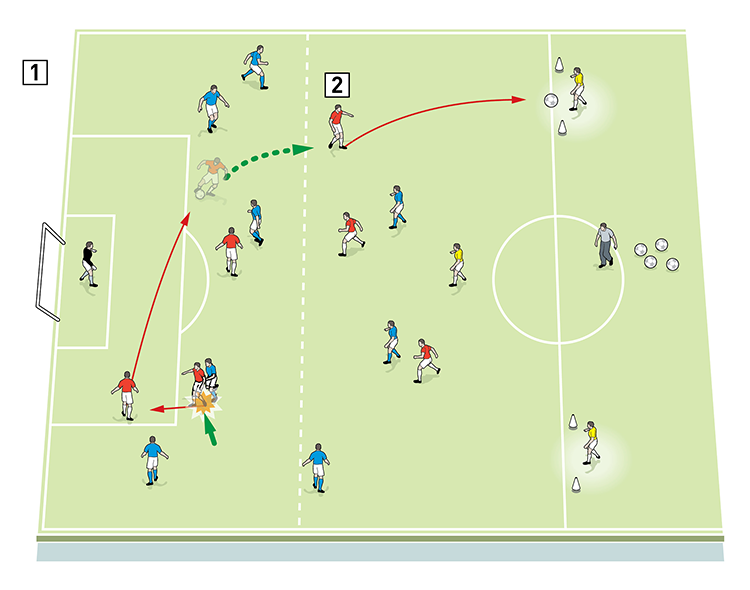
2. If the defending team wins the ball, they must find a way to play to the floating player or, as here, to one of the two target players
Work for set times, such as blocks of four minutes. If the attackers score or regain the ball, add time on; and if the defending team win the ball and manage to play forward passes to the target players or clear it to the floating player, then take time off. This will add a sense of competition.
Attackers can work on attacking patterns of play and creating 2v1 overloads out wide and can also be rewarded for regaining the ball in the attacking third.
How would you put this into a game situation?
11v10 game
Once the detail has been built by adding midfield players to the second activity, I will also add a striker to the defending team for this free game. His role is to encourage the ball down one side of the pitch when out of possession and also to be an outlet pass for the defending team when winning possession.
We set up on most of the pitch, with a full size goal and a goalkeeper at each end – the defending team’s goal is in its normal position but the attacking team’s goal is on the edge of the penalty area.
We’re using 19 outfield players, split into a blue attacking team of 10 and a red defending team of 9. The defending team should be stretched and must work hard because of the attacking overload against them – they must display good out-of-possession principles in order to compete. Plays starts and restarts with a pass out from the goalkeeper of the attacking team, as shown [3].
3
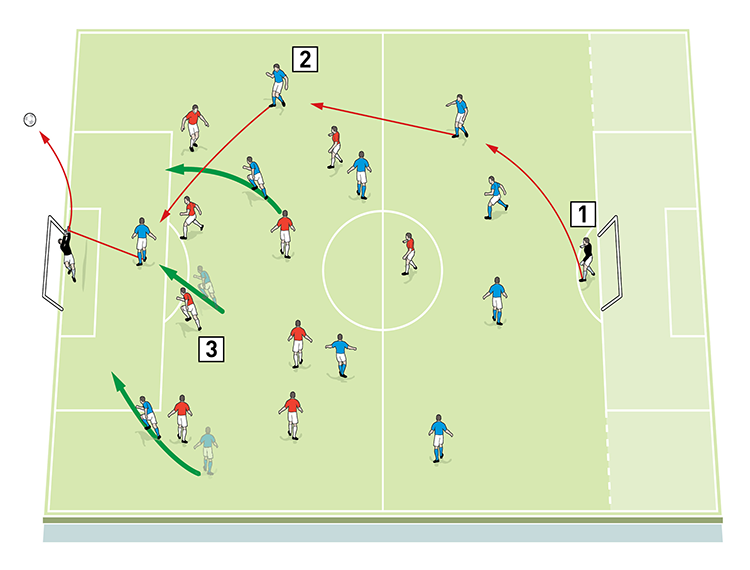
2. The blues have an overload and must try to score in the goal they are attacking
3. The red defending team will be stretched and must work hard to stop the blues scoring
Rotate players after several minutes and continue to monitor their understanding and performances.
What are the typical mistakes players might make and how do I avoid them?
We would coach good 1v1 defending technique as this can be neglected in the more realistic game scenarios. Also, we observe and correct any positional errors of the defenders and midfielders when looking to deal with balls from wide areas.
There must be good communication from all defending players, including the goalkeepers, and a desire to prevent the ball entering the penalty box. Defenders should also squeeze any negative passes made by the attacking players.
Related Files
Editor's Picks
Using the goalkeeper in build-up play
Pressing principles
Intensive boxes drill with goals
Penetrating the final third
Creating and finishing
My philosophy
Pressing initiation
Compact team movement
Defensive organisation
Coaches' Testimonials

Alan Pardew

Arsène Wenger

Brendan Rodgers

Carlos Carvalhal

José Mourinho

Jürgen Klopp

Pep Guardiola

Roy Hodgson

Sir Alex Ferguson

Steven Gerrard
Coaches' Testimonials

Gerald Kearney, Downtown Las Vegas Soccer Club

Paul Butler, Florida, USA

Rick Shields, Springboro, USA

Tony Green, Pierrefonds Titans, Quebec, Canada
Join the world's leading coaches and managers and discover for yourself one of the best kept secrets in coaching. No other training tool on the planet is written or read by the calibre of names you’ll find in Elite Soccer.
In a recent survey 92% of subscribers said Elite Soccer makes them more confident, 89% said it makes them a more effective coach and 91% said it makes them more inspired.
Get Monthly Inspiration
All the latest techniques and approaches
Since 2010 Elite Soccer has given subscribers exclusive insight into the training ground practices of the world’s best coaches. Published in partnership with the League Managers Association we have unparalleled access to the leading lights in the English leagues, as well as a host of international managers.
Elite Soccer exclusively features sessions written by the coaches themselves. There are no observed sessions and no sessions “in the style of”, just first-hand advice delivered direct to you from the coach.



